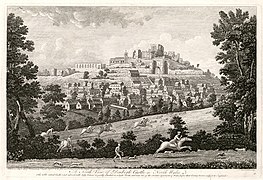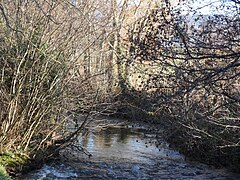Denbigh
Denbigh
| |
|---|---|
 Denbigh Library | |
Location within Denbighshire | |
| Population | 8,986 (2011) |
| OS grid reference | SJ053663 |
| Community |
|
| Principal area | |
| Preserved county | |
| Country | Wales |
| Sovereign state | United Kingdom |
| Post town | DENBIGH |
| Postcode district | LL16 |
| Dialling code | 01745 |
| Police | North Wales |
| Fire | North Wales |
| Ambulance | Welsh |
| UK Parliament | |
| Senedd Cymru – Welsh Parliament | |
| Website | denbightowncouncil.gov.uk |
Denbigh (/ˈdɛnbi/ DEN-bee; Welsh: Dinbych [ˈdɪnbɨχ]) is a market town and a community in Denbighshire, Wales. Formerly the county town of the historic county of Denbighshire until 1888,[1] Denbigh's Welsh name (Dinbych) translates to "Little Fortress"; a reference to its historic castle. Denbigh lies near the Clwydian Hills.
History
[edit]
Denbigh Castle, together with its town walls, was built in 1282 by order of King Edward I. The Burgess Gate, whose twin towers adorn the symbol on Denbigh's civic seal, was once the main entrance into the town. The first borough charter was granted to Denbigh in 1290, when the town was still contained within the old town walls. It was the centre of the Marcher Lordship of Denbigh. The town was involved in the revolt of Madog ap Llywelyn in 1294–1295; the castle was captured in the autumn and, on 11 November 1294, a relieving force was defeated by the Welsh rebels. The town was recaptured by Edward I in December. Denbigh was also burnt in 1400 during the revolt of Owain Glyndŵr.
During the Wars of the Roses (1455–1487), the town was largely destroyed, subsequently moving from the hilltop to the area of the present town market.[2]
Leicester's Church is an unfinished church. In 1579, Robert Dudley, 1st Earl of Leicester, who was also Baron of Denbigh, planned for there to be a cathedral. His intention was to move the status of city from neighbouring St Asaph. The project ran out of money and, when Robert Dudley died, it was left as ruins; it is now in the care of Cadw.[3]
In 1643, during the English Civil War, Denbigh became a refuge for a Royalist garrison. Surrendering in 1646, the castle and town walls eventually fell into ruin.[4]
The town grew around the textile industry in the 1600s, hosting specialist glovers, weavers, smiths, shoemakers, saddlers, furriers and tanners. Denbigh has been an important location for the agricultural industry throughout its history.[5]
Railway
[edit]Denbigh railway station once served the town on the former London and North Western Railway, later part of the London, Midland and Scottish Railway.
It was a junction for the Vale of Clwyd Railway line, which lead north to St Asaph and Rhyl, and the Mold and Denbigh Junction Railway. The former was closed in 1955, leaving Denbigh on a lengthy branch running from Chester to Ruthin, via Mold, which subsequently closed in 1962. A southern continuation beyond Ruthin, linking up with the Great Western Railway at Corwen, had closed in 1952.
The station site has been redeveloped since into a small retail park; however, remains of a platform can still be seen beside the road leading to the Home Bargains store, Aldi Supermarket, Screwfix and two charity shops.
North Wales Hospital
[edit]
At one time, the majority of the population sought employment at the North Wales Hospital, which, dating back to the 1840s, cared for people with psychiatric illnesses. The hospital closed in 1995 and has since fallen into disrepair. In October 2008, a special series of episodes of Most Haunted, titled Village of the Damned, was broadcast from the North Wales Hospital over 7 days.[6] As of October 2018, the derelict building has passed into the ownership of Denbighshire County Council.[7]
Futura Cinema
[edit]Denbigh had a town cinema on Love Lane. It opened as the Scala in 1928, before being re-branded as the Wedgwood Cinema in the late 1970s. It closed in October 1980, then reopened by Lewis Colwell in 1982 and renamed the Futura Cinema. The cinema closed again in the 1990s, but the building remained open as a video rental store. In 1995, Peter Moore reopened the cinema for a short period before being arrested and convicted of the murder of four men. The video rental store closed and the building is now in ruin awaiting redevelopment.[8] Denbigh has no permanent cinema, though Denbigh Film Club regularly operates in Theatr Twm o'r Nant.[9]
Population
[edit]The population at the 2001 Census was 8,783,[10] increasing to 8,986 in the 2011 census.,[11] reducing in the 2021 census to 8,669. [1][better source needed]
Amenities
[edit]
Attractions in the town include Denbigh Library, Denbigh Castle and the castle walls, Cae Dai 1950s museum, Theatr Twm o'r Nant, medieval parish church St Marcella's, and a small shopping complex. Denbigh Boxing Club is located on Middle Lane. Denbigh Community Hospital was established in 1807.[12] Denbigh Town Hall is a Grade II* listed building.[13]
Denbigh Cricket Club is one of the oldest cricket clubs in Wales having been established in 1844. The club plays at the Ystrad Road ground and plays in the North Wales Cricket League. The 1st XI play in the Premier Division having won the Division 1 championship in 2010 with the 2nd XI in Division 3.
For over 50 years, a barrel rolling competition has been held on Boxing Day in the town square.
Secondary schools
[edit]There are three secondary schools located in Denbigh. Denbigh High School is the larger of the two, consisting of nearly 600 pupils and approximately 60 staff. The current headmaster is Glen Williams.
St Brigid's is a Catholic voluntary aided school on Mold Road on the outskirts of the town which caters for pupils between the ages of 3 – 19. There is a strict admissions policy and until 2009 the school only accepted girls. The schools current headteacher is Leah Crimes.
Myddleton College is the former Howell's Preparatory School and is an independent co-educational day and boarding school.
All 3 of these High Schools in Denbigh, along with Ysgol Brynhyfryd (Ruthin), Ysgol Glan Clwyd (St Asaph), Denbigh College, and Llysfasi College (Deeside) have joined to offer a combined 6th form under the title 'The Dyffryn Clwyd Consortium'.[14]
Site of Special Scientific Interest
[edit]Crest Mawr Wood (alt. - Crêst) is a Site of Special Scientific Interest to the north west, adjoining Denbigh Golf Club and the Tarmac Quarry, an historic and ancient deciduous woodland. This woodland is endangered due to environmental pressure and competing land use in the area.
National Eisteddfodau
[edit]Denbigh hosted the National Eisteddfod of Wales in 1882, 1939, 2001 and 2013.
Notable people
[edit]

Note: Earl of Denbigh is an extant title of nobility held since 1622 by the Feilding family of Warwickshire. Despite taking their title from the town they are not known to have any other connection.
- Rhoda Broughton (1840–1920), novelist
- Elizabeth Casson (1881–1954) doctor and occupational therapy pioneer.
- Shefali Chowdhury (born 1988), actor, notably in the Harry Potter films
- CDawgVA (born 1996), YouTuber and podcaster, presenter of Trash Taste
- Robert Dudley, 1st Earl of Leicester (1532–1588), also known as Baron of Denbigh
- Thomas Gee (1815–1898), a Welsh Nonconformist preacher, journalist and publisher.[15]
- David Griffith (1800–1894), known as "Clwydfardd" a Welsh poet and Archdruid of the National Eisteddfod of Wales.
- Dr Samuel Johnson (1709–1784), visited friends and relation in Denbigh many times and has an urn memorial in his honour in the woods nearby.
- Professor Edward Taylor Jones (1872–1961), physicist
- Eirian Llwyd (1951–2014), printmaker and wife of former Plaid Cymru leader Ieuan Wyn Jones
- Humphrey Llwyd (1527–1568), a Welsh cartographer, author, antiquary and MP.[16]
- Sir Hugh Myddleton (1560–1631), royal jeweller, goldsmith and entrepreneur.[17]
- Thomas Myddelton (1550–1631) a Welsh merchant, Lord Mayor of London & MP
- Twm o'r Nant (1739–1810), playwright, real name Thomas Edwards
- Beatrix Potter (1866–1943), spent summers with her aunt and uncle at Gwaenynog Hall between 1895 and 1913 and used their large garden as inspiration for The Tale of Peter Rabbit
- Susan Reynolds (1929–2021) a medieval historian
- Kate Roberts (1891–1985), Welsh language writer.[18]
- Several members of the Salusbury Family, who represented Denbigh over the years.[19]
- Sir Henry Morton Stanley (1841–1904), a journalist and explorer[20][21][22]
- Mark Webster (born 1983) Welsh darts international, winner of the BDO World Darts Championship 2008
- Bryn Williams (born 1977), TV chef who won the Great British Menu BBC TV programme.
Gallery
[edit]-
1750 hunting scene by John Boydell
-
Denbigh c.1778 from Thomas Pennant's A Tour in Wales
-
Town and castle in 1786
-
1808 engraving by James Storer
-
Denbigh painted by a travelling French artist c.1830
-
North-east view of the hospital, 1850s
-
Fairytale River
References
[edit]- ^ "Denbigh (33082)". Coflein. RCAHMW. Retrieved 1 January 2024.
- ^ "Denbigh, Clwyd, Wales". Archived from the original on 30 January 2008. Retrieved 30 November 2007.
- ^ St David's or Leicester's Church, Denbigh (ID NPRN93307). at the Royal Commission on the Ancient and Historical Monuments of Wales (RCAHMW)
- ^ "Welcome to Denbigh". Retrieved 30 November 2007.
- ^ "The History of Denbigh". Retrieved 14 November 2018.
- ^ "Village of the Damned". Most Haunted. 25 October 2008.
- ^ "Council takes over Denbigh's North Wales Hospital". BBC News. 12 October 2018. Retrieved 14 November 2018.
- ^ "Cinema Treasures: Wedgwood Cinema in Denbigh". Retrieved 14 November 2018.
- ^ "Denbigh Film Club". Retrieved 14 November 2018.
- ^ "2001 Census: Denbigh (Parish)". Office for National Statistics. Archived from the original on 25 May 2011. Retrieved 30 November 2007.
- ^ "Town population 2011". Archived from the original on 4 March 2016. Retrieved 22 May 2015.
- ^ "Denbighshire Community Hospital, Denbigh". National Archives. Retrieved 24 February 2019.
- ^ Cadw. "Town Hall (23591)". National Historic Assets of Wales. Retrieved 22 May 2022.
- ^ Team, UCAS Media Technical. "UCAS Progress: Dyffryn Clwyd Partnership". www.ucasprogress.com.
- ^ . Encyclopædia Britannica. Vol. 11 (11th ed.). 1911. p. 549.
- ^ "Humphrey Lloyd profile". BBC Wales. Retrieved 7 December 2006.
- ^ . Encyclopædia Britannica. Vol. 19 (11th ed.). 1911. pp. 110–111.
- ^ "Kate Roberts profile". BBC Wales. Retrieved 7 December 2006.
- ^ . Encyclopædia Britannica. Vol. 24 (11th ed.). 1911. pp. 66–67.
see final para.
- ^ "Henry Morton Stanley profile". BBC. Retrieved 2 February 2019.
- ^ "HM Stanley statue unveiled in his home town of Denbigh". BBC News. Retrieved 2 February 2019.
- ^ Cana, Frank Richardson (1911). . Encyclopædia Britannica. Vol. 25 (11th ed.). pp. 779–781.
External links
[edit]- . Encyclopædia Britannica. Vol. 8 (11th ed.). 1911. pp. 17–18.
- BBC Wales's Denbigh website
- http://cadw.wales.gov.uk/docs/cadw/publications/Urban_Character_Denbigh_EN.pdf











